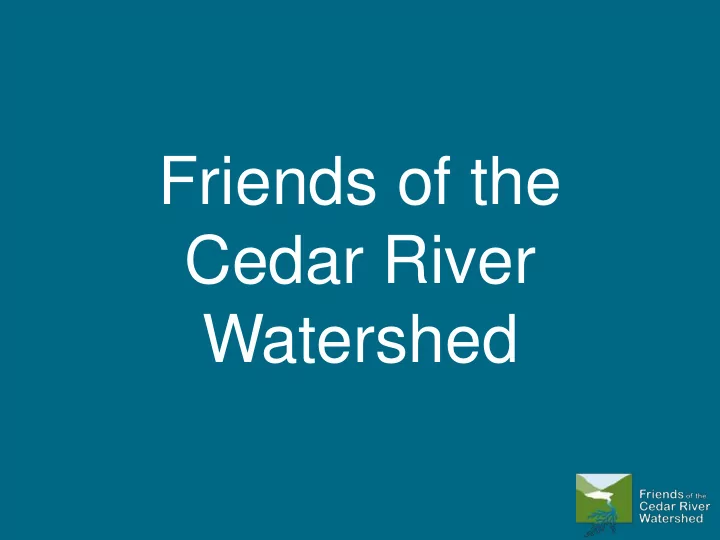

Friends of the Cedar River Watershed
V ISION Healthy watersheds through personal and community engagement. Mission Engaging people to enhance and sustain watersheds through restoration, education and stewardship.
Volunteer Habitat Restoration Cedar River Salmon Journey Stewardship in Action
Cedar River Salmon Journey Salmon are the vehicle through which we tell the story of clean water and healthy habitat.
History • Started in 1998 by King County, Seattle Aquarium and Seattle Public Utilities • Program coordination: • King County 1998-2005 • Aquarium in 2006 • FCRW 2007-present • Partners contribute significant staff time and supplies • Volunteers and partnerships key to success
Mission Promote understanding and stewardship of the Cedar River/Lake Washington ecosystem from the mountains to the sound.
Goals • Inform and inspire 10,000+ watershed residents about critical needs facing the watershed. – Salmon – Watershed health – Solutions • Promote everyday actions that we can all take to improve watershed health.
Program Growth • 16 years on the Cedar River sharing the story of salmon and healthy watersheds • Number of participants increases every year: 114 volunteers spoke with 13,517 visitors in 2013 32% increase in visitors and a 13% increase in volunteers from 2012 • More sites and year-round opportunities for volunteers to engage with the public about salmon recovery
Audience & Opportunity • General public is a high CRSJ Visitors 1998-2013 priority audience 16000 • 14000 Salmon viewing opportunities 12000 June-December 10000 8000 • Continued learning at FCRW 6000 restoration events, 4000 2000 community events and e- 0 communications year-round “One of the most important roles of public outreach is heightening awareness about the fact that everyone within the watershed has a role in the health of salmon and water quality.” WRIA 8 Plan, chapter 5, page 3.
Salmon Programs • Every weekend in October • 3 Saturdays at the Chittenden Locks during salmon migration • At restoration and community events throughout the year
Volunteer Training Fall Program ~ salmon, watershed, interpretation (20 hours) Summer Program~ salmon, nearshore environment, Locks (4 hours) associated with the program to be one of ~ CRSJ Volunteer Naturalist
Teaching Tools • Vests, hats and name badges • Posters and flyers • Props such as egg display, fish glove, native plant id cards, otolith and diagram, magnet board etc • Salmon!
Located in Tier 1 areas • primary spawning areas • migratory and rearing corridors Sites
What We Talk About • Human and natural history, land use changes, water quality and watershed health • Salmon of the Cedar River, life cycle and population trends • What can I do to help ? We facilitate the correction of misinformation and engage people with respect.
What Do Visitors Learn?
What Action Will Visitors Take? 62% will use compost and avoid pesticides 54% will take care of their cars by fixing oil leaks 54% will use a commercial car wash 38% will plant a native tree to help control stormwater runoff 34% will drive less 18% will volunteer to help restore habitat Bi-annual follow up calls reveal that the majority of survey takers are following through on their action pledges.
Local Audiences Majority of riverside visitors are from Renton and Maple Valley area.
Reinforcing the Message • Volunteers and FCRW staff present at community events • E-newsletters and social media reach additional audiences and incorporate salmon education as well as resources for more information
Evaluation • Written surveys for visitors (843 surveys received in 2013) • On-line surveys for volunteers (59 evaluations received in 2013) • Bi-annual phone calls surveying stewardship actions (2010, 2012, 2014) 84% of those reached by phone in 2014 were taking action
Volunteer Naturalist Feedback • I love being a Cedar River Naturalist, because I am addicted to "aha moments", and I can 100% guarantee that every public contact I have • I have been inspired both by the way that it makes me feel and the way that I am giving back to the community/environment that I live in I can see that I make a difference in the lives of people who I am able to interact with. • Amazing. I didn't think people would be as interested and engaged about salmon and the Sound as they were. It was a great experience and remarkable to see how the public responded. Most long-term volunteers are from Renton and Maple Valley area.
Program Impact • Over 85,655 visitors since 1998. • Volunteers have donated 26,707 hours valued at $550,520. • Participants become engaged in stewardship activities.
Supports WRIA8 Start List • Meets WRIA 8 Start List recommendation for community outreach and education (# Project C711) • Addresses and reinforces the collective missions of WRIA8, FCRW, Cedar River Council, King County WLRD and Puget Sound Partnership. • Participants learn to be salmon-friendly stewards
Builds Support for Salmon Recovery Actions • Provides clear messages about things everyone can do • Elevates public awareness of salmon and watershed issues • Connects people with hands-on opportunities through programs like Stewardship in Action and Volunteer Habitat Restoration • Encourages visitors and volunteers to take action
Builds Capacity Builds on lessons learned • Project partners evaluate season • Assess and adapt as needed • Try new tools and methods Enhances existing efforts and builds partnerships • U.S. Army Corps of Engineers • Beach Naturalist program • FCRW Volunteer Habitat Restoration • Cascade Bicycle Club, Audubon, Hyatt • Salmon Watchers
What’s Next? 2014: • Collaboration with the Salmon Watchers And • increase salmon and watershed health education through improved social networking, media and public outreach initiatives • pilot weekday programming for schools • continue looking for opportunities to develop new partnerships across WRIA8 (restoration, Lake WA)
Salmon Viewing Map • Salmon Watcher data and photos • Updated weekly through December • Educational component
Partners and Sponsors
30
Recommend
More recommend